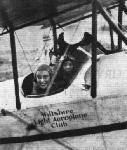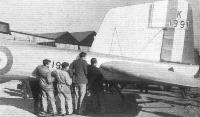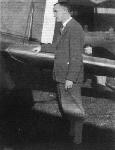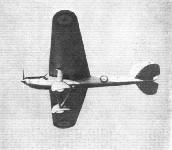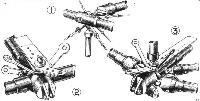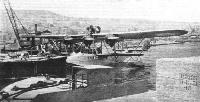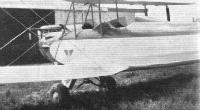Фотографии
-
Mr. C. F. Uwins, of the Bristol Aeroplane Co., gives the crowd a thrill during a demonstration of high-speed flying in a Bristol "Bulldog" Fighter.
Самолёты на фотографии: Bristol Bulldog - Великобритания - 1927
-
Регистрационный номер: G-EBMM THE HANDLEY PAGE W.10: This was a 1926, an improved model of the original W.8B. The engines, however, were Napier "Lions."
Самолёты на фотографии: Handley Page H.P.18 (W.8) / H.P.30 (W.10) - Великобритания - 1919
-
Регистрационный номер: K-107 THE VICKERS "VIMY COMMERCIAL": A commercial version of the "Vimy" bomber, with two Napier "Lions," originally operated by Instone Air Line Ltd., since 1920.
Самолёты на фотографии: Vickers Vimy Commercial - Великобритания - 1919
-
One of the 1931 S.6 B machines. Next to it one of the 1929 S.6's.
Самолёты на фотографии: Supermarine S.5 / S.6 - Великобритания - 1927
-
Регистрационный номер: N219 One of the 1927 S.5's.
Самолёты на фотографии: Supermarine S.5 / S.6 - Великобритания - 1927
-
IN FLIGHT: The port rudder is seen swung outward to make the machine steer to the left.
Самолёты на фотографии: Lippisch Delta I - Германия - 1930
-
THE "HERMANN KOHL": This view from below gives a good idea of the plan form of the tailless machine
Самолёты на фотографии: Lippisch Delta I - Германия - 1930
-
THE THREE-WHEELED UNDERCARRIAGE: The front wheel is steerable.
Самолёты на фотографии: Lippisch Delta I - Германия - 1930
-
THE POWER PLANT: The engine is a Bristol "Cherub" driving a pusher airscrew.
Самолёты на фотографии: Lippisch Delta I - Германия - 1930
-
A BIRD'S EYE VIEW: The trailing edge flaps are divided into elevators and ailerons.
The Lippisch Delta I of 1930 was so called because of its swept-back leading edge and straight trailing edge.Самолёты на фотографии: Lippisch Delta I - Германия - 1930
-
The second AW 16, A-2, flying at Whitley Abbey in October 1931
In spite of its high powered radial air-cooled engine the A.W.XVI looks very clean even for a single-seater fighter. The height of the pilot's head shows that he had the seat in its top position when our photograph was taken.Самолёты на фотографии: Armstrong Whitworth Scimitar / A.W.16 / A.W.35 - Великобритания - 1931
-
THE SINGLE SEATER: The Armstrong-Whitworth A.W.XVI (Armstrong-Siddeley Jaguar Major). This three-quarter rear view shows off the clean lines of this fast machine to good advantage.
Самолёты на фотографии: Armstrong Whitworth Scimitar / A.W.16 / A.W.35 - Великобритания - 1931
-
THE A.W.XVI: The well faired undercarriage and the efficient Townend ring engine cowling ate particularly noticeable in this view.
Самолёты на фотографии: Armstrong Whitworth Scimitar / A.W.16 / A.W.35 - Великобритания - 1931
-
A CLEAN UNDERCARRIAGE: Both the Armstrong-Whitworth Atlas II and A.W.XVI have well faired undercarriages with "spats" over the wheels. Our sketch shows what an admirable result has been achieved.
Самолёты на фотографии: Armstrong Whitworth Scimitar / A.W.16 / A.W.35 - Великобритания - 1931
-
The new brackets for holding on the Townend ring are shown on the right. The steel links A are flexible while the bushes B are of rubber and the pins C are a loose fit. The resulting flexibility has obviated cracking of the ring.
Самолёты на фотографии: Armstrong Whitworth Scimitar / A.W.16 / A.W.35 - Великобритания - 1931
-
DETAILS THAT COUNT: Above, our artist shows how the tail lamp has been fitted snugly into the rudder, while below he depicts the method by which the tail plane has been faired to the fuselage of both the Atlas II and A.W.XVI.
Самолёты на фотографии: Armstrong Whitworth Atlas / Ajax - Великобритания - 1925Armstrong Whitworth Scimitar / A.W.16 / A.W.35 - Великобритания - 1931
-
OUT OF THE SLIPSTREAM: The electrical generators on these new Armstrong-Whitworth aircraft have been placed inside the fuselage fairing. Our sketch, here shows the generator for lighting and heating on the right-hand side of the machines. The view on the left illustrates the clean result when the fairing panel is over the generator and shows the two ventilators for keeping it cool.
Самолёты на фотографии: Armstrong Whitworth Scimitar / A.W.16 / A.W.35 - Великобритания - 1931
-
FOR THE PILOT'S COMFORT: The Armstrong-Whitworth A.W.XVI has the above method of adjusting the pilot's rudder bar.
Самолёты на фотографии: Armstrong Whitworth Scimitar / A.W.16 / A.W.35 - Великобритания - 1931
-
The neat interplane strut end fairings and their method of assembly are shown.
Самолёты на фотографии: Armstrong Whitworth Scimitar / A.W.16 / A.W.35 - Великобритания - 1931
-
Armstrong-Whitworth A.W.XVI Armstrong Siddeley "Panther" Mk.IV Engine
Самолёты на фотографии: Armstrong Whitworth Scimitar / A.W.16 / A.W.35 - Великобритания - 1931
-
Lady Page and daughter, Miss Joan Page, arrive at the Garden Party after flying from Hanworth in a "Genet-Redwing." Miss Page is an enthusiastic member of the Wiltshire Light Aeroplane
Club.Самолёты на фотографии: Robinson Redwing - США - 1930
-
Регистрационный номер: X967Y [2] Самолёты на фотографии: Douglas Dolphin / RD / OA-4 - США - 1930
-
The "Dolphin" flying over mountainous country in California.
Самолёты на фотографии: Douglas Dolphin / RD / OA-4 - США - 1930
-
Регистрационный номер: X967Y [2] A side view of the Douglas "Dolphin" amphibian.
Самолёты на фотографии: Douglas Dolphin / RD / OA-4 - США - 1930
-
A photograph taken with ordinary hand-camera through glass windscreen of "Dolphin."
Самолёты на фотографии: Douglas Dolphin / RD / OA-4 - США - 1930
-
Douglas "Dolphin" (Amphibian) 2-300 h.p. Wright "Whirlwind" Engines
Самолёты на фотографии: Douglas Dolphin / RD / OA-4 - США - 1930
-
Регистрационный номер: F-ALLK The Caudron "Luciole" C.270 open cockpit biplane, fitted with a 95 h.p. Salmson engine.
Самолёты на фотографии: Caudron C.230 / C.270 / Luciole - Франция - 1930
-
IN HER NATIVE HOME: The Klemm Two-seater taken at Boblingen where Herr Klemm has his factory. The neat engine cowling of this model is made possible by the small overall dimensions of the Hirth motor, while it being inverted gives the pilot an excellent view. It has 4 cylinders and gives 80 h.p.
Самолёты на фотографии: Klemm L.25 - L.28 Swallow - Германия - 1927
-
Регистрационный номер: G-ABRR A LIGHTER LIGHT PLANE: We show above a novel mascot made by A. E. Lejeune, Ltd., of Gt. Portland St., W.I, and designed by Mr. R. A. Allan. It is a model of a D.H. "Puss Moth," about 7 in. span, made in the form of a cigarette lighter.
Самолёты на фотографии: De Havilland Puss Moth / D.H.80 - Великобритания - 1929
-
Регистрационный номер: K1991 [4] Самолёты на фотографии: Fairey Long-Range Monoplane - Великобритания - 1928
-
Регистрационный номер: K1991 [4] The rudder of this year's Fairey (Napier) Monoplane has a new design of balance but the whole tail retains its extremely clean appearance.
Самолёты на фотографии: Fairey Long-Range Monoplane - Великобритания - 1928
-
Регистрационный номер: K1991 [4] Mr.F. Rowarth explaining the details of the tailplane to a friend. The mass of calculations he has made for the flight appears to have furrowed his brow somewhat.
Самолёты на фотографии: Fairey Long-Range Monoplane - Великобритания - 1928
-
Регистрационный номер: K1991 [4] The Fairey (Napier) Long Range Monoplane flying at Cranwell recently.
Самолёты на фотографии: Fairey Long-Range Monoplane - Великобритания - 1928
-
Регистрационный номер: G-ABKE THE ATLAS II: Such points as the new rudder shape, the built-in tail lamp, the neat "slots," and general cleanliness make it immediately apparent as to where this efficient two-seater gets its performance.
Самолёты на фотографии: Armstrong Whitworth Atlas / Ajax - Великобритания - 1925
-
STEEL CONSTRUCTION: Sketches 1, 2 and 3 are typical examples of Armstrong-Whitworth steel tube construction. They show, in particular, the ball and cup method of attaching the vertical fuselage struts.
Самолёты на фотографии: Armstrong Whitworth Atlas / Ajax - Великобритания - 1925
-
Armstrong-Whitworth Atlas Mk.II Armstrong Siddeley Panther Mk.IIIA Engine
Самолёты на фотографии: Armstrong Whitworth Atlas / Ajax - Великобритания - 1925
-
Регистрационный номер: VH-UQE BRISBANE TO ADELAIDE IN ONE DAY: Mr. F. H. Broadbent leaving Essenden (Melbourne) aerodrome after refuelling during his one-day solo flight through four States from Brisbane to Adelaide on August 12. This flight was made in a Sports "Avian," using Shell spirit.
Самолёты на фотографии: Avro Avian / Type 594/616 - Великобритания - 1926
-
Регистрационный номер: G-ABHF [3] PEDIGREE FORDS: Prize sheep from the flock of Mr. John Langmead, of Ford, Sussex, under the wing of one of the Ford monoplanes.
Самолёты на фотографии: Ford Tri-Motor / 4-AT / 5-AT - США - 1926
-
Регистрационный номер: G-ABHF [3] HENRY FORD, HIS MARK: The "Wasp" powered 5AT demonstrator with its appropriate registration letters flying over its home aerodrome.
Самолёты на фотографии: Ford Tri-Motor / 4-AT / 5-AT - США - 1926
-
Регистрационный номер: G-ABHF [3] SOLID BEAUTY: The 5AT is a very graceful machine and although quite fast - its top speed is 150 m.p.h. - does not, in consequence, lose its air of solid comfort. The centre engine will in future also have a Townend ring type of cowling around it.
Самолёты на фотографии: Ford Tri-Motor / 4-AT / 5-AT - США - 1926
-
DETAILS THAT COUNT: Great attention has been paid to the streamlining of such details as the undercarriage on the 5AT Pullman. The way in which the radius rod and axle are faired into the "spat" is shown very clearly in these pictures.
Самолёты на фотографии: Ford Tri-Motor / 4-AT / 5-AT - США - 1926
-
Регистрационный номер: G-EBEV The "Bristol" 10-seater, with Bristol "Jupiter" engine.
Самолёты на фотографии: Bristol Ten-Seater / Brandon - Великобритания - 1921
-
Регистрационный номер: G-EBMW THE DE HAVILLAND 66, "HERCULES": A three-engined (Bristol "Jupiter VI") biplane used on the Middle-East route.
Самолёты на фотографии: De Havilland Hercules / D.H.66 - Великобритания - 1926
-
Регистрационный номер: N240 THE SARO A 7 AT ALGIERS: A picturesque view of the R.A.F. flying boat refuelling with Shell aviation spirit at Algiers during its recent cruise to the Near East.
Самолёты на фотографии: Saunders-Roe Severn / A.7 - Великобритания - 1930
-
Регистрационный номер: G-EBEM THE VICKERS "VULCAN'": One of the 1924 additions to the Imperial Airways fleet. It had a Napier "Lion" and carried seven passengers.
Самолёты на фотографии: Vickers Vulcan / Type 61 - Великобритания - 1922
-
THE Do-K: The latest type to be produced by the Dornier works of Friedrichshafen, a four-engined commercial landplane. The engines are Walter "Castors."
Самолёты на фотографии: Dornier Do.K - Германия - 1929
-
THE STRUCTURE: On the left an end view of a wing, and on the right the skeleton of the front portion of the fuselage. The main fuselage structure is of steel tube.
Самолёты на фотографии: Dornier Do.K - Германия - 1929
-
THE DO.K IN FLIGHT: The projections behind the engines are the mudguards over the wheels.
Самолёты на фотографии: Dornier Do.K - Германия - 1929
-
THE DO K WING IN SKELETON: The wing is a three-spar structure, the spars being girders built up of channel sections.
Самолёты на фотографии: Dornier Do.K - Германия - 1929
-
The wing after covering.
Самолёты на фотографии: Dornier Do.K - Германия - 1929
-
CAREFUL STREAMLINING: This side view of the Do K indicates that considerable care has been taken to reduce resistance.
Самолёты на фотографии: Dornier Do.K - Германия - 1929
-
FRONT VIEW OF DO.K: The engine and undercarriage strutting is simple and apparently robust.
Самолёты на фотографии: Dornier Do.K - Германия - 1929
-
FAIRING A "MOTH." - Mr. Ralph Kenyon, of Newtonville, Mass., U.S.A., writing to the de Havilland Co., claims marked improvements in the performance of an English "Moth" he has streamlined-up. Having built a false bottom to the fuselage, and faired all strut fittings, all landing gear fittings, the petrol tank into the wings, the wings into the fuselage, the headrest into the fin, bridged the gaps in the ailerons, elevators and rudder, and constructed a detachable front cockpit cover and windshield, he has obtained a top speed of 134 m.p.h. and a cruising speed of 120 m.p.h. The take-off and stalling speeds, he says, were not noticeably impaired, but the gliding ratio was increased. The accompanying illustration shows an American "Moth" thus treated.
Самолёты на фотографии: De Havilland Gipsy Moth / Moth X - Великобритания - 1928
-
A PRUFLING: Mr. Gibbons of the London Gliding Club manages a long flight in the Club's Prufling in spite of the light wind.
Самолёты на фотографии: Lippisch / RRG Prufling - Германия - 1926
-
WELL UP: The little Scud caused a lot of enthusiasm for British built gliders at the recent International Glider Meeting at Balsdean. F. O. Mole made several excellent flights on it and E. D. Abott, Ltd., of Farnham, the builders, together with Mr. L. E. Baynes, the designer, will we trust reap the benefit of their enterprise.
Самолёты на фотографии: Abbott-Baynes Scud - Великобритания - 1931
-
A beginner's soarer, the Hols der Teufel with a member of the London Gliding Club just taking off. Herr Hirth soared in this machine during the meeting. This machine was designed in 1923 by Herr Lippisch, the designer of Herr Kronfeld's "Wien."
Самолёты на фотографии: Lippisch / RRG Hols der Teufel - Германия - 1923
-
The Albert A.62 low-wing monoplane, with 95 h.p. Renault. A similar machine, but with a 95 h.p. Salmson, was also entered.
Самолёты на фотографии: Albert A-60 - Франция - 1930
-
Самолёты на фотографии: Gloster, Monospar ST-3 - Великобритания - 1931
-
THE MONOSPAR: The clear view which the pilot has ahead, whichever side of the machine he is sitting, is shown very clearly in this view. In its latest form a small airwheel replaces the tail skid which makes handling on the ground exceptionally easy.
Самолёты на фотографии: Gloster, Monospar ST-3 - Великобритания - 1931
-
Самолёты на фотографии: Gloster, Monospar ST-3 - Великобритания - 1931
-
The Bleriot Guillemin J.G.10 low-wing monoplane, with 95 h.p. Renault. Trouble with the petrol feed system "eliminated" this machine from the competition.
Самолёты на фотографии: Guillemin JG.10 - Франция - 1931
-
A ONE MAN EFFORT: The "Crested Wren" designed and built by Corporal Manual of Hawkinge. It is a beautiful piece of work.
Самолёты на фотографии: Manuel Wren - Великобритания - 1931
-
A cleaned-up primary where the pilot is to a certain extent enclosed in a nacelle, and bearing a family resemblance to the "Hols der Teufel."
Самолёты на фотографии: Lippisch / RRG Hangwind - Германия - 1930
-
Gustav Lilienthal's flapping wing machine.
Самолёты на фотографии: Lilienthal, Gustav Grosser Vogel - Германия - 1915
Статьи
- Flight




















